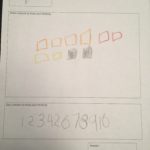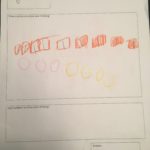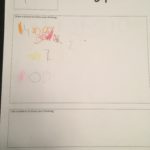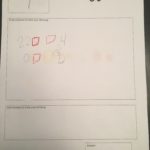Over the past few months I’ve been asked for videos that capture a 3-Act Task being taught in the elementary grades. I didn’t have any, or know of anyone that has captured an elementary 3-Act except for this Teaching Channel piece.
Before moving forward, this post wouldn’t be possible without Dan’s trailblazing skills and introducing us all to 3-Act Tasks.
Last week while visiting a kindergarten class we tackled the Candyman. So in the spirit of vulnerability, here it is and I’ll take whatever feedback you can offer.
Act 1: Notice and Wonder
***The blur will disappear after 30 seconds. Little man had to blow his nose***
Act 2: Identify Variables and Solve Conflict
Here’s the kindergarten recording sheet our friends used to make estimates and show their thinking.
After students estimated, we shared and identified the variables needed to answer the question, “How many candies were in Mr. Fletcher’s hand?”
At this point students were good to go and got their model on. We didn’t scaffold learning in any way because we were using this as a formative assessment.
Here’s what we got…
The context and colors of the candies really helped students explain and model their thinking.
Not all was gravy. There’s still lots of work to go but that’s to be expected. It’s kindergarten and we’re in October.

This student has mastered the art of drawing zeros. Lots of them.
Others looked rough too…

But when we looked closer and talked with the student, they counted the square pencil boxes for us. Awesome to uncover this hidden gem.
Really surprised to see this…

But my mind was blown with this little guy…

10 was his answer but 8 is what he modeled.
So we wanted to know more…
Mic drop.
Act 3: The Reveal
It’s always great to engage the youngins’ in 3-Act Tasks. I’ve heard colleagues say, “I don’t have time to do these types of lessons.”
I hope this helps in showing that we don’t have time, to not have the time.
Thoughts and feedback welcome.





This was awesome. Out Math guide doesn’t do it the way you did. I really like the whole group concept where you wrote down what the kids, “noticed” and then “what do you wonder”. Partner discussions is great and it was so simple but the kids had to think about each step. All were intrigued as well.
Thank you so much for posting this! I am a K-5 math coach, but when I taught I was in upper elementary. So seeing this done in a primary classroom gave me great ideas on how to support our primary teachers as we begin to implement more 3 Act Tasks. 🙂
I have done these math thinking tasks in grades K-2. Math is about thinking, wondering and discovering and these tasks do exactly that. So much language and discussion during these sessions! Sometimes I am amazed at what things my students think. They sometimes see things in different ways that I have not thought of. It helps me with my own adult approach to thinking about math through the eyes of my students. My students have been engaged and have enjoyed using their thinking to solve the tasks at hand. Mr. F you have created a great tool for developing math thinking for young minds. Thank you!
Love this! This is such a great visualisation of how powerful 3-Act Maths lessons can be! I’ve been singing the praises of it to my team, but being able to show it is that much more powerful. It’s my first year teaching Kindergarten, so it’s great to see how this plays out in someone else’s kindergarten classroom.
I often ask them for estimates that are too high and estimates that are too low and to justify their thinking. Is this something you omitted just because of the amount of time on the carpet or because of the time of year?
Yes, we have time in our classrooms for this. This is a word problem, teachers do them all day however, we forget to take the time to break them down and examine them, we turn them into “number grabbers” by giving them too much infomation up front ( I learned that from Dan Meyer). Thank you for putting this out there and showing all of us this can absolutely be done.
Hi Graham! Thanks so much for posting this. I’m a math coach and interested in helping my team implement some 3-Act tasks into their units. I love the opportunity for this to be formative assessment pre and post unit. Do you use some sort of rubric or documentation sheet to document where each child’s understanding is? My district is very data and documentation driven and feel like my higher ups will be more behind me if we have some sort of documentation! Hope that makes sense!
Thanks for sharing your knowledge and experience!
This is also a pattern I’ve been learning about science instruction -“I notice, I wonder, It reminds me of”. (and John Muir Laws emphasis in science journaling): https://www.youtube.com/watch?v=ekBP9bsc3KM
I really appreciate this video. We are using Three Phase Lessons in our district and I would like to create PD around 3 Act Tasks for our schools who are already doing Three Phase as an option to mix things up and engage learners in another way. I asked Robert Kaplinsky about videos finding out like you did that there are only 2 on teaching channel and he shared his video soon after. And now I am really happy to see your video also. I am wondering with the Three Acts is there any kind of debrief or discussion of solution methods /revise thinking with the whole group before or after revealing the answer. Thank you Graham for creating and sharing this.
Glad to help out Lisa and thanks for the kind words.
Funny enough, I’ve had quite a few requests asking about the closing of a lesson. This definitely seems like something we could all benefit from me capturing. I’m on it.
Thanks for the comment and sorry for the late reply.
connecting to “gfletchy.com” via dy/dan…this is a WONDERFUL blog and SUPER lesson! thank you for modeling 3-acts!
Graham, this warms my heart.
Always appreciate your videos!
My four year old and I just went through these videos and did the 3-act along with the kids.
It was interesting for her to hear the notice and wonder discussion from the other kids and to see their written work. She also thought your ring might be a candy (in the 3rd act reveal). Also, she immediately understood the work from the student with the two invisible white candies, so that might be a somewhat common issue that other teachers will see from their students.
Some other things I noticed and wondered about:
(1) there wasn’t any certainty among the students about the value of the coin. I think penny, dollar, quarter were all said.
(2) The candies are called “Chicle Tabs” which, I think, someone misread as “Circle Tabs,” which could be confusing because they are square (square pillows?)
Great points Joshua. With it being so early in the year I don’t think students have had mush exposure to coins. Recognizing coins and their values is an absolute beast and an ongoing struggle for everyone.
The “Chicle Tab” threw me for a loop as well so I’ll definitely agree with your point here.
Love the fact that you dove in and gave this a whirl with your little one. I crazy when kids make connections before we ever do (ie: white candy and your daughter).
I absolutely love your 3 Acts! I learned about them at NCTM last year. I am a 2nd year coach and I did “Share the Love” in a few first grade classes today. I let the kids choose the manipulatives they wanted. It was amazing to see all the different ways they modeled the problem using cubes, number bonds, teddy bears, rekenrek, even a hundred chart etc. They all agreed that Dad should get the extra M & M! Thanks for sharing the kindergarten class. I’m headed there next. Please keep the 3 Acts coming! Your website has been invaluable to me; I have learned so much!!!
I agree…the dad should always get the leftovers:-) Thanks for the kind words Kim and let us know how it goes.
I’m new to trying 3-Act tasks and I’m doing them with my intervention students. So this really helped to clarify some points for me. Thank you for that. It’s never easy to record oneself but you did it and then actually published it online! Kudos to you.
Vulnerability is the birthplace of professional growth. I really inspired how teachers are taking to the Internet and challenging themselves with the #Observeme Challenge. I guess this is just on a much larger scale:-)
Thanks so much for posting this! As a middle school teacher who has recently started working with K-2 teachers on math, it’s really helpful for me to see what a 3-Act looks like at this level. After the 1st act, I wasn’t sure what the 2nd act would be–how could you give more information without giving away the answer? But the second out was the perfect amount of information with kids still needing to recognize and represent numbers and then count all of them (or use some other strategy to add).
Less is more in this case. Most of the times K-1 students don’t immediately identify the missing variables. When this happens, I’ll share the thoughts of another class or blame it on the teacher down the hallway. Either way, I always try to make sure that the variables shared in Act-2 are never my idea.
Let us know how it goes in your crazy K-2 world. Thanks for the comment Nicole and sorry for the late reply.
Nicely done! I liked how you spent so much time on the noticing and wondering part as well as had students identify all the variables (colors of candies) before getting into the problem. I recently tried the Less than Train from 101questions as my first time doing a 3 Act in kinder. Kinders can definitely do this type of problem solving!
Thanks Ramona. I’m always really purposeful to slow down at the beginning of the task and really flush out the notice and wonders. Many times students ignore the context of the problem and when we rush through that part we’re pretty much doing the same. I love diving in with the littlins’ because I always leave with a smile, happy, and content.
Thanks for sharing Graham. I am going to share this with my Kinder folks, Ontario is really pushing play based learning in FDK to Grade 2 right now which we all know is great but we also know there still needs to be guided math activities and problem solving. I feel that some of our folks in FDK are going full on play-based and forgetting that we still need a balanced math block and mixture a teaching strategies. Graham have you seen the OECD PISA report called 10 Questions for Mathematics Teachers? here is the link if you have not. It is pretty awesome and filled with great suggestions and ideas to share with teachers about what they are finding out through the PISA tests world wide. One of the sections talks about the importance of having a variety of teaching and learning strategies. Thanks again for sharing.
All really important pieces you’ve brought up here Mark, thanks.
I took a look at the 10 questions article from PISA and you were right…well worth the read.
If anyone else is interested in reading the article, you can find it here http://www.oecd-ilibrary.org/education/ten-questions-for-mathematics-teachers-and-how-pisa-can-help-answer-them_9789264265387-en
“We don’t have time to NOT have time” YES!
Really interesting response from your student who answered 10 but showed 8. Did you get any more info? I’m thinking that maybe he knew that there were 2 white ones but didn’t show them because of the color?
I did. That’s exactly what happened and it was awesome to listen to him explain his reasoning. The video shows how he made sense of it.